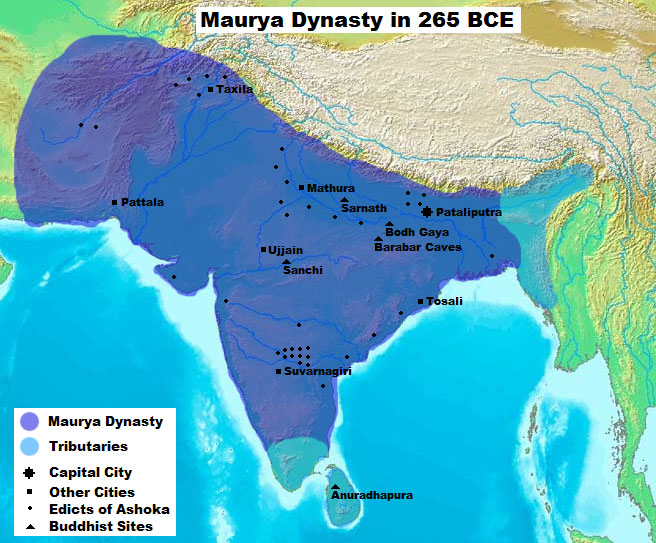22. The First Unification of India (322 – 185 BCE)
Summary The Indian subcontinent was for the first time unified by the Maurya Empire (322 – 185 BCE), which was founded by Chandragupta Maurya. Pataliputra was its capital, and at its peak it stretched from Afghanistan in the west to the Ganges Delta in the east. After a brutal war the ruler Ashoka the Great (r. 268 – 232 BCE) adopted Buddhism as his religion and propagated it in India and beyond.
Keywords Buddhism; Chandragupta Maurya; History of South Asia; Indus Valley Civilization

A map of the Maurya Empire. At its peak it extended to Afghanistan in the west, to the Ganges Delta in the east, and to the Himalaya in the north. Pataliputra was its capital. (© User:Vastu / Wikimedia Commons / CC-BY-SA-3.0)
The Indus Valley Civilization, centered around the Indus and its tributaries in today’s Pakistan, existed from about 3300 BCE to 1300 BCE, at the same time as the early civilizations in Mesopotamia and Egypt. It mainly thrived from about 2600 BCE to 1900 BCE, and famous cities of that era were Mohenjo-daro and Harappa. The knowledge of the actual history of that civilization is, however, limited, as the writing system of that time – the Indus script – is not deciphered till now. The Indus Valley Civilization was followed by the Aryan invasions in the context of the Indo-European migrations, in an era of decline and abandoned cities, and by the Vedic period from about 1500 BCE to 500 BCE. The Vedic period is named after the Vedas which were religious texts of Hinduism.
From about 500 BCE on the “second urbanization” took place, after the “first urbanization” of the Indus Valley Civilization of two millennia before, as new cities were founded in the Ganges Plain east to the Indus Valley. New states were formed, such as the Kingdom of Magadha in today’s southern Bihar, being located in eastern India. Then Alexander the Great, the Macedonian conqueror of the Persian Achaemenid Empire, advanced into the Indus Valley, the former most eastward province of the Persians, and tried to incorporate it into his short-lived empire with limited success in 327-325 BCE. Shortly after that Chandragupta Maurya (r. 322-298 BCE) founded the Maurya Empire in 322 BCE, when he conquered the Nanda Empire in the Gangetic plain. Chanakya was one of his advisors and wrote the Arthashastra, a famous ancient Indian treatise on statecraft. Pataliputra, which is besides today’s Patna in Bihar and which was the capital of the former Nanda Empire, was also made the capital of the Maurya Empire. The Maurya Empire was the first empire in history which eventually unified most of the Indian subcontinent.

A depiction of the Indian emperor Ashoka the Great (left, r. 268-232 BCE) and a Buddhist monk (right). (© User:Kutara / Wikimedia Commons / CC-BY-SA-4.0)
During the time of its greatest extent the Maurya Empire extended from Assam in the east, to Balochistan and the Hindu Kush mountains in the west, and to the Himalaya in the north. It encompassed the region along the Grand Trunk Road from Chittagong in today’s Bangladesh in the east to Kabul in today’s Afghanistan in the west. The Maurya Empire reached its peak during the reign of Ashoka the Great (r. 268-232 BCE). Brutal fights during the Kalinga War (around 262-261 BCE) let him adopt Buddhism and propagate this peaceful religion in whole India and beyond. The Lion Capital of Ashoka at Sarnath is today the national emblem of India. Buddhism was based on the teaching of Gautama Buddha, who lived around 500 BCE, was born as a prince and later became an ascetic monk. Another religious teacher of that time was Mahavira, an important teacher in the Jainism religion.
The Maurya Empire eventually declined and was overthrown in 185 BCE. Another later influential empire in Indian history was the Gupta Empire between the 3rd and the 6th centuries CE which also had Pataliputra as its capital, however it was mostly restricted to northern India. India did not witness an empire as large as the Maurya Empire again until the Islamic invasions. Buddhism declined in India during the 1st millennium CE, except in the Himalayan region and in the south, and was largely replaced by Hinduism.
